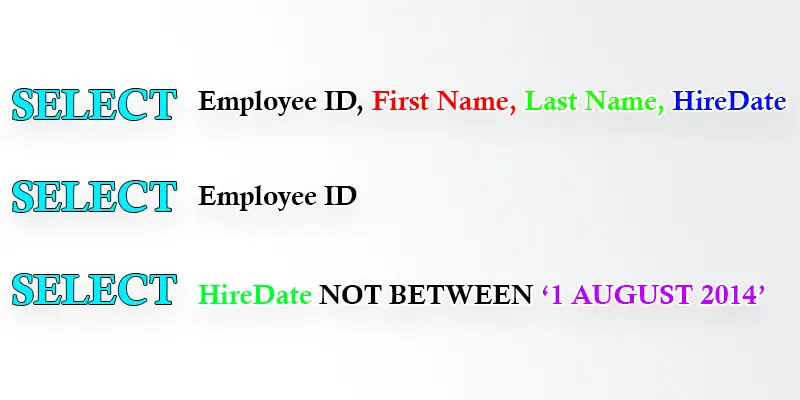SQL Queries Syntax | Top 20 SQL Commands and Statements
Published: 11 Nov 2024
What is the Correct SQL Query Syntax for Beginners
When working with databases, SQL (Structured Query Language) is the tool used to manage and manipulate data. SQL has a specific structure, known as syntax, which outlines how queries must be written to communicate with the database. This syntax follows certain rules and conventions to ensure the database understands your commands.
While SQL is flexible with letter casing, writing keywords in uppercase is a common practice for better readability. Understanding SQL syntax is essential for performing operations like retrieving, inserting, and updating data reliably and consistently.

Most Commonly Used SQL Statements with Examples
To perform tasks on data stored in a database, you use SQL commands written in a specific format known as SQL syntax. This syntax is a set of structured rules that ensures the database understands the instructions. SQL statements are made up of easy-to-read keywords that guide the database on what to do. For example, you can retrieve data from a table, add new entries, or modify existing records using these commands.
Here’s an example: The following SQL statement retrieves all records from a table called “Customers”:
SELECT * FROM Customers;
In this tutorial, we will review each of the key SQL statements used to maintain and work with data in a database. We will also discuss how to use straightforward, understandable commands to obtain, add, update, and delete data. In conclusion, you will have a thorough understanding of SQL statement functionality.
How to Create and Use Database Tables in SQL
Similar to a spreadsheet, a database table stores data in rows and columns. Each row represents a record (like information about a person or product), and each column represents a specific detail about that record (like name, age, or price).
For example, in a table called “Customers,” each row could store details about a different customer, and the columns might include “Name,” “Email,” “Phone Number,” “Country,” “Postal Code,” and “City.” Tables organize data in a structured way, so it’s easy to search, manage, and analyze.
Here’s a simple representation of a database table for customers, including the specified columns:
| ID | Name | Phone Number | City |
|---|---|---|---|
| 1 | Sarah Smith | 987-654-3210 | Los Angeles |
| 2 | Mark Taylor | 555-123-4567 | Chicago |
| 3 | Emily Davis | 444-987-6543 | Houston |
| 4 | David Brown | 222-333-4444 | Miami |
| 5 | John Doe | 123-456-7890 | New York |
In this table:
- Customer ID is a unique number assigned to each customer.
- Customer Name is the name of the company or individual.
- The phone number provides a way to contact the customer directly.
- The city provides additional details about the customer’s location.
This structure helps you easily organize and access customer information.
Is SQL Case Sensitive in Table and Column Names
Case sensitivity refers to whether or not uppercase and lowercase letters are treated as different characters. In some programming languages and systems, including certain databases, it matters if you write a word in uppercase or lowercase.
For example, in a case-sensitive system:
- “Customer” and “customer” would be considered two different names.
In contrast, both versions would be treated the same in a case-insensitive system.
In SQL, the case sensitivity can depend on your database system. Generally, SQL keywords (like SELECT, INSERT, etc.) are not case-sensitive, meaning you can write them in any combination of uppercase or lowercase letters. However, the names of tables and columns may be case-sensitive in some databases, so it’s good practice to be consistent with how you write them.
Should there be a Semicolon after a SQL Statement?
Yes, a semicolon is often used at the end of SQL statements to indicate the end of the command. It helps the database understand where one statement finishes and another begins. While some database systems allow you to omit the semicolon for single statements, it’s a good practice to include it, especially when writing multiple statements in a script.
| Most Important SQL Commands and Statements |
|---|
|

“Let’s discuss each statement one by one, providing its syntax and an example for each.”
Select
SELECT is a statement that retrieves data from a database. It functions similarly to requesting specific information from a database. You have the option of extracting every row or just specific columns of data from a table.
| Syntax |
|---|
SELECT column1, column2, … FROM table_name;
|
Example
SELECT Name, City FROM Customers;
This query will show the “Name” and “City” columns from the “Customers” table.
In this example, the database will return a list of customer names and the cities they are from. If you want to get all the columns, you can use SELECT *, which means selecting everything from the table. The SELECT statement is one of the most commonly used commands in SQL because it’s how you pull data to view or analyze.
How to use SELECT DISTINCT to Remove Duplicate Values in SQL
The SELECT DISTINCT statement is used to get unique values from a column, removing any duplicates. It helps when you only want to see each item once, even if it appears multiple times in the data.
| Syntax |
|---|
SELECT DISTINCT column1, column2, … FROM table_name;
|
Example
SELECT DISTINCT City FROM Customers;
This query will show each city only once from the “Customers” table, even if multiple customers are from the same city.
In this example, the database will return a list of cities without repeating any city that appears more than once. The SELECT DISTINCT command is useful when you want to filter out duplicates and get a clean list of unique entries from your data.
How to Use WHERE Clause in SQL to Filter Data
The WHERE clause is used to filter records and get only the data that matches a certain condition. It helps you narrow down your search to find specific information.
| Syntax |
|---|
SELECT column1, column2, … FROM table_name WHERE condition;
|
Example
SELECT * FROM Customers WHERE Country = ‘USA’;
This query will show all customers who are from the USA.
In this example, the WHERE clause filters the data so that only customers whose “Country” is “USA” will be shown. The WHERE clause is useful when you only need records that meet a specific condition, like filtering by a country, age, or any other detail in the data.
Step-by-Step Guide to use INSERT INTO in SQL
The INSERT INTO statement is used to add new data (or records) to a table. It’s like filling in a new row in your database with the information you want to store.
| Syntax |
|---|
INSERT INTO table_name (column1, column2, …) VALUES (value1, value2, …);
|
Example
INSERT INTO Customers (Name, City, Country)
VALUES (‘Alice’, ‘New York’, ‘USA’);
This query will add a new customer, Alice, from New York, USA, to the “Customers” table.
In this example, a new row is added to the “Customers” table with the values provided for “Name,” “City,” and “Country.” The INSERT INTO statement is useful when you want to input new records into your database, like adding new customers, orders, or any other type of data.
How to write SQL UPDATE Statements to Change Records
The UPDATE statement is used to modify existing data in a table. It allows you to change values in one or more columns for specific records.
| Syntax |
|---|
UPDATE table_name SET column1 = value1, column2 = value2, … WHERE condition;
|
Example
UPDATE Customers
SET City = ‘Los Angeles’
WHERE Name = ‘Alice’;
This query updates the city of the customer named Alice to “Los Angeles.”
In this example, the UPDATE statement changes the “City” column for the customer named Alice. The WHERE clause ensures that only Alice’s record is updated. The UPDATE command is useful when you need to change information in your database, like updating an address, a price, or any other detail for specific records.
How to Use SQL DELETE Command Safely with Examples
The DELETE statement is used to remove data from a table. It allows you to delete specific records that meet a certain condition.
| Syntax |
|---|
DELETE FROM table_name WHERE condition;
|
Example
DELETE FROM Customers
WHERE Name = ‘Alice’;
This query will remove the customer named Alice from the “Customers” table.
The DELETE statement removes Alice’s record from the table in this example. The WHERE clause ensures that only the record matching the condition (Name = ‘Alice’) is deleted. The DELETE command is helpful when you need to clean up your database by removing unnecessary or outdated data. Without a WHERE clause, all records in the table would be deleted, so it’s important to be careful when using it!
How to Use CREATE TABLE in SQL with Syntax and Example
The CREATE TABLE statement is used to make a new table in a database. A table is where you store your data, and it consists of columns (for different types of information) and rows (for each data entry).
| Syntax |
|---|
CREATE TABLE table_name ( column1 datatype, column2 datatype, … );
|
Example
CREATE TABLE Customers (
CustomerID INT,
Name VARCHAR(255),
City VARCHAR(100),
Country VARCHAR(100)
);
This query creates a table called “Customers” with four columns: “CustomerID” (a number), “Name” (text up to 255 characters), “City” (text up to 100 characters), and “Country” (text up to 100 characters).
The CREATE TABLE statement creates a table where you can store customer data in this example. Each column is defined by the specific type of data it will hold. The CustomerID column stores numbers, while the other columns store text. The CREATE TABLE command is essential when setting up a database because it defines where and how your data will be organized.
How to Use ALTER TABLE to Add or Change Columns in SQL
The ALTER TABLE statement is used to make changes to an existing table. You can add new columns, change existing columns, or even remove columns from the table.
| Syntax |
|---|
ALTER TABLE table_name ADD column_name datatype;
|
Example
ALTER TABLE Customers
ADD Email VARCHAR(255);
This query adds a new column called “Email” to the “Customers” table, where you can store email addresses.
In this example, the ALTER TABLE statement modifies the “Customers” table by adding a new ” Email ” column.” The VARCHAR(255) means the column will store text with up to 255 characters. You can also use ALTER TABLE to change the type of a column, rename a column, or delete a column. It’s a useful command when you need to adjust your table structure after it’s been created.
How to Use DROP TABLE to Remove a Table in SQL
The DROP TABLE statement is used to completely delete a table from the database. Once you drop a table, all the data and the table structure are permanently removed.
| Syntax |
|---|
DROP TABLE table_name;
|
Example
DROP TABLE Customers;
This query will remove the “Customers” table and all the data stored in it from the database.
In this example, the DROP TABLE statement deletes the entire “Customers” table from the database. This means all the data in the table will be lost permanently, and the table itself will no longer exist. Use the DROP TABLE command carefully because once a table is dropped, it cannot be recovered unless you have a backup.
What is SQL JOIN and How Does it Work with Examples
The JOIN statement is used to combine data from two or more tables in a database based on a common column between them. It helps you see related data from different tables in one result.
| Syntax |
|---|
SELECT columns FROM table1 JOIN table2 ON table1.column_name = table2.column_name;
|
Example
SELECT Customers. Name, Orders.OrderID
FROM Customers
JOIN Orders
ON Customers.CustomerID = Orders.CustomerID;
This query combines the “Customers” and “Orders” tables, displaying the customers’ names together with their order IDs.
In this example, the “Customers” and “Orders” tables are connected using the JOIN statement, which uses the shared field “CustomerID.” This allows you to see which customer made which order. The JOIN is useful when you need to combine related information from different tables, such as linking customer details with their order history. Without using JOIN, you’d have to look at each table separately, which can be inefficient.
How to use INNER JOIN to Combine Data from Multiple Tables
The INSERT JOIN combines the INSERT and JOIN statements to add data into a table by selecting values from another table that are related through a common column. This is useful when you want to insert data based on existing relationships between tables.
| Syntax |
|---|
INSERT INTO table1 (column1, column2, …) SELECT columnA, columnB, … FROM table2 JOIN table3 ON table2.common_column = table3.common_column;
|
Example
INSERT INTO Orders (CustomerID, ProductID)
SELECT Customers.CustomerID, Products.ProductID
FROM Customers
JOIN Products
ON Customers.Country = Products.Country;
This query inserts data into the “Orders” table by selecting customer and product information from the “Customers” and “Products” tables based on matching countries.
In this example, the INSERT JOIN adds new data to the “Orders” table by selecting information from the “Customers” and “Products” tables. The JOIN part ensures the data is connected by a common attribute (Country in this case), so it only inserts relevant data. This is useful when adding data that depends on existing relationships, such as assigning products to customers based on their location.
How Does LEFT JOIN work in SQL with Easy Example
The LEFT JOIN statement is used to combine rows from two tables based on a related column. It retrieves all the records from the left table and the matched records from the right table. If there is no match, the result will include NULL values for the columns from the right table.
| Syntax |
|---|
SELECT columns FROM table1 LEFT JOIN table2 ON table1.common_column = table2.common_column;
|
Example
SELECT Customers. Name, Orders.OrderID
FROM Customers
LEFT JOIN Orders
ON Customers.CustomerID = Orders.CustomerID;
The “Customers” table contains all of the customers’ names, while the “Orders” table contains each customer’s order ID. A customer’s name will still appear even if they haven’t placed any orders; however, the OrderID will be displayed as NULL.
Whether a customer has placed any orders or not, the LEFT JOIN statement in this example ensures that they are all listed. The customer’s name will appear in the result, but the OrderID will be NULL if they haven’t placed an order. The LEFT JOIN is helpful when you want to see all records from the primary table (Customers) and any related information from the secondary table (Orders), even if some records don’t have matching entries. This helps identify customers who may need follow-up for potential orders.
Difference between LEFT JOIN and RIGHT JOIN in SQL
The RIGHT JOIN statement is used to combine rows from two tables based on a related column. It retrieves all the records from the right table and the matched records from the left table. If there is no match, the result will include NULL values for the columns from the left table.
| Syntax |
|---|
SELECT columns FROM table1 RIGHT JOIN table2 ON table1.common_column = table2.common_column;
|
Example
SELECT Customers. Name, Orders.OrderID
FROM Customers
RIGHT JOIN Orders
ON Customers.CustomerID = Orders.CustomerID;
This query retrieves all order IDs from the “Orders” table along with the corresponding customer names from the “Customers” table. If an order does not have a matching customer, the OrderID will appear, but the customer name will show as NULL.
In this example, the RIGHT JOIN statement ensures that every order is listed, regardless of whether there is a matching customer. If there is an order without an associated customer, the result will show the OrderID, but the Customer Name will be NULL. The RIGHT JOIN is useful when you want to see all records from the secondary table (in this case, Orders) and any related information from the primary table (Customers), even if some records don’t have matching entries. This helps identify orders that may need clarification regarding their customers.
How to Use FULL JOIN in SQL to Merge All Table Data
The FULL JOIN (or FULL OUTER JOIN) statement combines rows from two tables based on a related column. It retrieves all records from both the left and right tables. If there is a match between the two tables, it shows the combined data; if there is no match, it includes NULL values for the columns from the table that don’t have a game.
| Syntax |
|---|
SELECT columns FROM table1 FULL JOIN table2 ON table1.common_column = table2.common_column;
|
Example
SELECT Customers. Name, Orders.OrderID
FROM Customers
FULL JOIN Orders
ON Customers.CustomerID = Orders.CustomerID;
This query retrieves all customer names from the “Customers” table and all order IDs from the “Orders” table. If a customer has not placed any orders, their name will still appear with a NULL OrderID. Conversely, if there are orders without matching customers, those OrderIDs will be listed with a NULL customer name.
In this example, the FULL JOIN statement ensures that you get every record from both the “Customers” and “Orders” tables. If there is a customer with no orders, their name will appear with a NULL value for OrderID. Similarly, if there are orders that do not have a corresponding customer, those OrderIDs will show with a NULL value for the customer name. The FULL JOIN is useful when you want to see a complete overview of data from both tables, including cases where there are unmatched records. This can help identify customers without orders and without associated customers, providing a comprehensive view of the data.
What is GROUP BY in SQL and Why is it Important
The GROUP BY statement is used to arrange identical data into groups. It is often used with aggregate functions (like COUNT, SUM, AVG) to perform calculations on each group of data. This helps summarize information and understand data trends.
| Syntax |
|---|
SELECT column1, aggregate_function(column2) FROM table_name GROUP BY column1;
|
Example
SELECT City, COUNT(CustomerID) AS NumberOfCustomers
FROM Customers
GROUP BY City;
This query counts the number of customers in each city and displays the results grouped by city.
In this example, the GROUP BY statement groups the records in the “Customers” table by the “City” column. The COUNT(CustomerID) function counts how many customers are in each city. The result will show each city along with the number of customers from that city.
Using GROUP BY is useful when you want to see summarized data, such as how many entries belong to each category or group. It helps in analyzing patterns and making data-driven decisions, like identifying which cities have the most customers.

Difference Between HAVING and WHERE in SQL
The HAVING clause filters groups created by the GROUP BY statement. It allows you to specify conditions on aggregated data, restricting the results based on the results of aggregate functions (like COUNT, SUM, AVG).
| Syntax |
|---|
SELECT column1, aggregate_function(column2) FROM table_name GROUP BY column1 HAVING condition;
|
Example
SELECT City, COUNT(CustomerID) AS NumberOfCustomers
FROM Customers
GROUP BY City
HAVING COUNT(CustomerID) > 5;
This query counts the number of customers in each city and only shows cities that have more than 5 customers.
In this example, the HAVING clause is applied after the GROUP BY statement. The query groups the records in the “Customers” table by the “City” column and counts the number of customers in each city. The HAVING COUNT(CustomerID) > 5 condition filters the results, so only cities with more than 5 customers are displayed.
Using HAVING is essential when you want to filter groups based on aggregate results. It helps in focusing on significant data points, such as identifying cities that have a substantial customer base, allowing for more targeted analysis and decision-making.
How to Sort Query Results Using ORDER BY in SQL
The ORDER BY statement sorts the result set of a query based on one or more columns. You can arrange the data in ascending order (from smallest to largest) or descending order (from largest to smallest). By default, the sorting is done in ascending order.
| Syntax |
|---|
SELECT columns FROM table_name ORDER BY column1 [ASC|DESC], column2 [ASC|DESC];
|
Example
SELECT Name, City, Age
FROM Customers
ORDER BY Age DESC;
This query retrieves the names, cities, and ages of customers and sorts the results by age in descending order, showing the oldest customers first.
The ORDER BY statement sorts the records in the “Customers” table based on this example’s “Age” column. By using DESC, the query arranges the customers from oldest to youngest. If you wanted to sort in ascending order, you could use ASC or leave it out altogether.
Using ORDER BY is useful when you want to present data in a specific order, such as ranking customers by age, listing products by price, or organizing sales data by date. This makes it easier to analyze and understand the information.
How to Use LIMIT in SQL to Get Specific Number of Records
The LIMIT clause is used to specify the maximum number of records to return in a query. This is helpful when you only want to see a subset of the data, like the first few rows of a large result set.
| Syntax |
|---|
SELECT columns FROM table_name LIMIT number;
|
Example
SELECT Name, City
FROM Customers
LIMIT 5;
This query retrieves the names and cities of the first 5 customers from the “Customers” table.
The LIMIT clause restricts the output to only the first 5 records from the result set in this example. If the “Customers” table has many entries, using LIMIT allows you to quickly see a sample of the data without overwhelming you with too much information.
Using LIMIT is particularly useful in scenarios where you want to preview data, such as displaying a list of recent transactions, showing top-selling products, or paginating results in an application. It helps improve performance and user experience by reducing the amount of data returned in a single query.
How to Search with Patterns Using LIKE in SQL
The LIKE operator is used in SQL to search for a specified pattern in a column. It is often used with the WHERE clause to filter results based on partial matches, including wildcards representing one or more characters.
| Syntax |
|---|
SELECT columns FROM table_name WHERE column_name LIKE pattern;
Wildcards
|
Example
SELECT Name
FROM Customers
WHERE Name LIKE ‘A%’;
This query retrieves the names of all customers whose names start with the letter “A.”
In this example, the WHERE clause uses the LIKE operator to filter the results from the “Customers” table. The pattern ‘A%’ specifies that we want names that start with “A” followed by any number of characters (including none). As a result, the query will return names like “Alice,” “Adam,” and “Aaron.”
Using LIKE is helpful when you need to search for specific patterns in text fields, such as finding names, email addresses, or any other string data. It provides flexibility in querying data by allowing for partial matches rather than requiring exact matches.
How to Handle NULL Values in SQL Queries
In SQL, NULL represents a missing or unknown value in a database. It is not the same as an empty string or a zero; it simply means that no value exists in that field. You can use NULL to indicate that a particular piece of data is not available or has not been entered.
| Syntax |
|---|
To check for NULL values, you typically use the IS NULL or IS NOT NULL condition in a query. SELECT columns FROM table_name WHERE column_name IS NULL; |
Example
SELECT Name, Age
FROM Customers
WHERE Age IS NULL;
This query retrieves the names and ages of customers whose age is not specified (i.e., NULL).
In this example, the IS NULL condition checks the “Age” column in the “Customers” table for any records where the age has not been entered. If a customer’s age is missing, the query will return that record.
Using NULL is important for data integrity and accurate reporting. It allows you to distinguish between records with no data and those with actual values, helping you to manage and analyze your data effectively. For instance, knowing which customers haven’t provided their age can inform follow-up actions or data-cleaning efforts.
Conclusion About Why Learning SQL Syntax and Commands is Important for Data Handling
SQL syntax provides a structured way to communicate with databases and perform various operations on data. Understanding the basic syntax rules is essential for writing effective queries, whether you’re retrieving, updating, or managing data. SQL statements like SELECT, INSERT, UPDATE, and DELETE are built on these syntax principles, allowing users to manipulate data efficiently. Clauses such as WHERE, GROUP BY, and ORDER BY allow you to focus your search and obtain the precise data you require. By mastering SQL syntax, you can unlock the full potential of database management and make data-driven decisions more effectively.
FAQS – SQL is Command
Another name for SQL Syntax is SQL Language. It refers to the set of rules and words used to write commands in SQL.
While most SQL Syntax follows standard rules, different database systems (like MySQL, PostgreSQL, and Oracle) might have some variations in syntax or additional features.
No, SQL isn’t a piece of software. It’s a programming language for database management and interaction. Still, many software applications use SQL to facilitate user data manipulation.
Yes, SQL is considered a type of coding or programming. It allows you to write instructions on how to manipulate and retrieve data from databases.
SQL syntax is the set of rules for writing SQL statements. It usually includes commands like SELECT, FROM, and WHERE.
The five main SQL commands are SELECT, INSERT, UPDATE, DELETE, and CREATE. These help you work with data in databases.
No, MongoDB uses a different syntax based on JSON-like queries. It does not follow traditional SQL syntax.
Basic SQL queries include SELECT * FROM table, INSERT INTO, UPDATE, and DELETE. These let you read and manage data.
SQL syntax is used in database systems like MySQL, PostgreSQL, and SQL Server. It helps manage and access structured data.
Yes, SQL is considered easy for beginners. Its commands use simple English words and follow a clear structure.
C++ does not have a full form. The name means it’s an improved version of the C language (“++” means increment).
Start with SELECT, choose the columns, then add FROM and the table name. Example: SELECT name FROM users;
Use the DELETE FROM command with a condition. Example: DELETE FROM users WHERE id = 1;
Read the error message carefully it shows what went wrong. Fix any typos, check table or column names, and correct the syntax.
Use the SELECT * FROM table_name; command. It shows all columns and rows from the selected table.

- Be Respectful
- Stay Relevant
- Stay Positive
- True Feedback
- Encourage Discussion
- Avoid Spamming
- No Fake News
- Don't Copy-Paste
- No Personal Attacks

- Be Respectful
- Stay Relevant
- Stay Positive
- True Feedback
- Encourage Discussion
- Avoid Spamming
- No Fake News
- Don't Copy-Paste
- No Personal Attacks





